
The Basics:
- For ages 8 and up (publisher suggests 13+)
- For 3 to 5 players
- Approximately 30 minutes to complete
Geek Skills:
- Counting & Math
- Logical & Critical Decision Making
- Reading
- Pattern/Color Matching
- Hand/Resource Management
Learning Curve:
- Child – Easy
- Adult – Easy
Theme & Narrative:
- Promote boxers, make money, repeat
Endorsements:
- Gamer Geek mixed!
- Parent Geek approved!
- Child Geek approved!
Overview
Legendary boxing promoter Don King said, “I don’t promote boxing, I promote people. Boxing is a catalyst to bring people together.” In this game, players will be doing the same. It’s not about the boxing, it’s about the people and the money it attracts. As a boxing promoter, you need to work with other promoters to create engaging boxing matches, but you don’t want your boxer to lose. Losers don’t take home paychecks.
Top Promoter, designed by Justin Moore and published through Game Saltue, is comprised of 15 Location cards, 100 Player cards (15 Boxer and 5 Action cards in 5 different colors), 14 standard six-sided dice (7 blue, 7 red), 21 One Million Dollar chips, 14 Five Million Dollar chips, and 7 Ten Million Dollar chips. The cards are as durable as your standard playing card and the chips are made of thick cardboard. The illustrations by artist Michael Scarola are colorful and stylized, giving a game a unique look.
Game Set Up
To set up the game, first take the 15 Location cards, shuffle them, and then return some Location cards back to the game box. The number of cards to be returned is dependent on the number of players in the game. For example, in a 3-player game, 9 Location cards are removed, but in a 5-player game, only 3 Location cards are removed.
Second, draw and place 1 Location card per player, minus one, to the middle of the playing area. Place the remaining Location cards face-down. The following image is an example of Location cards being set up for a 3-player game. Each Location card will play host to 3 fights (indicated by the Lower Card, Mid Card, and Main Event grey card areas). These areas are referred to a the Location’s “bouts”. Think of the bout areas as a ladder. The closer the fighter gets to the Location card, climbing the ladder of success, they closer they are to the Main Event!
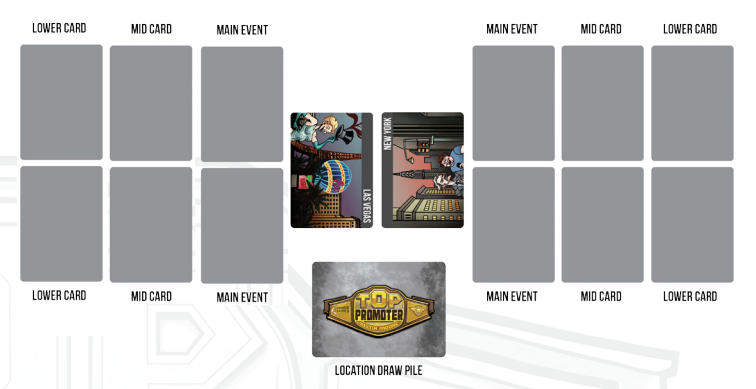
Second, each player takes a set of 20 Player cards. All of the cards should be the same color. Each player shuffles their own cards and draws 6 for their starting hand. The rest of the Player cards are placed face-down next to the player. This is the player’s draw pile for the duration of the game.
That’s it for game set up. Place the dice and chips to one side and begin!
Introduction to Boxing Promoting
In this game, players will never be stepping into the ring or taking a punch to the face. Instead, they’ll be in the crowd watching the fight and taking hits to their wallet. A player’s only goal in Top Promoter is to make money and to do that the player will need to create bouts between boxers that will generate excitement. Each player has the same number of Boxer cards to use during the game. They will use the Boxer cards to stage bouts with boxers that belong to other players. This is done in a semi-cooperative manner, as each player wants a good bout and must follow certain rules in order for the bout to take place. If a boxer doesn’t fight, then they won’t earn money. However, players don’t want their boxer to lose, either. Understanding the information on a Boxer card is essentially to creating the perfect boxing match.

Location, location, location! Boxing promoters need to find locations that can host their fights, bring in the crowds, and will make the match all the more interesting. Furthermore, boxers tend to do just a little bit better when they are competing in their hometown. Boxing promoters can use this to their advantage. They can also spread their boxers around, picking good matches, and avoid some locations altogether.
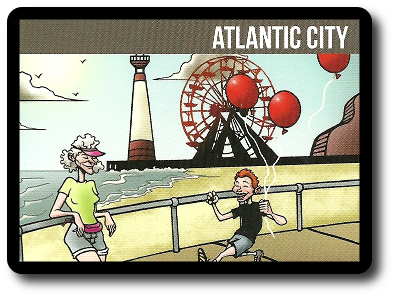
The Art of Entertaining
Top Promoter is played in rounds and will last for as long as there are Location cards to host a boxing match. A round of game play is summarized here.
Step 1: Draw Cards
All players draw cards from their draw pile until they have 6 cards. If this is the first round of game play, this step is skipped. When the player’s draw pile is exhausted, they cannot draw anymore cards. Discarded cards are out for the duration of the game.
Step 2A: Play Cards
Each player now selects 1 Boxer card from their hand and places it face-down in front of them. Once all the players have placed their card, they are revealed simultaneously. From here, things get a bit involved. Starting with the player who has the Boxer card with the highest Popularity value, followed by the next, highest and so on until all the Boxer cards are placed, the following steps are taken.
- The Boxer card must be played to 1 of the 6 open bout areas at a Location card. Each Location card can support up to 3 bouts and each bout supports 2 Boxer cards from different players.
- All Boxer cards in the same bout must be paired with another Boxer card in the same weight class. This rule forces players to match weight classes first before they can assign a Boxer card to a new bout area.
- If the Boxer card cannot be legally placed to a Location card or bout area, the Boxer card is discarded. Thematically speaking, the player could not negotiate a boxing match.
After the player places their Boxer card, they have the option to play 1 Action card from their hand to any Boxer card they have in play. This includes the Boxer card they just played or any Boxer cards they played in previous rounds. Only specific Action cards can be played at this time. These include “Location Change”, “Cable Special”, and “Press Conference” Action cards.
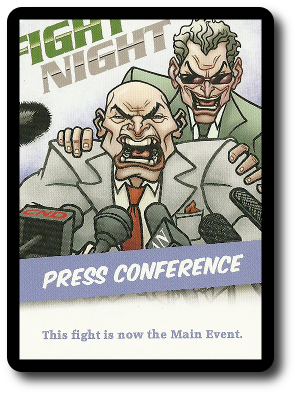
If the player didn’t fill a Location card’s bouts, the next player with the highest Popularity value now places their Boxer card.
Step 2B: Resolve Locations and Payout
If a player places the 6th Boxer card at a Location card, all 3 bouts are now ready to be resolved. The game temporarily pauses and no additional Boxer cards are placed (as noted in step 2A) until the Location and all of its bouts have been resolved.
Each bout is resolved separately, starting with Lower Card, then Mid card, and finally the Main Event. The players who own the Boxer cards in the bout being resolved grab a number of six-sided dice equal to their Boxer card’s Dice value. If the Location card matches the Boxer card’s Hometown, the player adds +1 die. When rolling, it helps if both players take different colored die.
Before rolling, players can decide to play a “Superior Training” or “Random Drug Test” Action card from their hand. Depending on the Action card used, the player can earn an extra die or eliminate their opponent due to a drug test coming back…well…you get the picture.
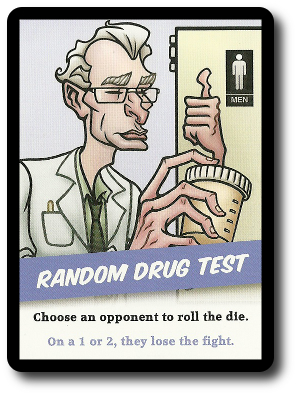
After any Action cards are played, resolved, and discarded, the dice are rolled. The players arrange the rolled values from highest to lowest, from left to right. Both rows of dice are now reviewed.
An automatic Knockout (KO) is declared if the player rolled a specific sequence of dice values. Bonus die added do not change the Boxer card’s base Dice value, but the bonus dice can be used to help make a KO!
- x3 KO! = a Three-of-a-Kind (example, 3, 3, 3 on the dice)
- x4 KO! = a Run-of-Four (example, 6, 5, 4, 3 on the dice)
- x5 KO! = a Full House (example, 5, 5, 5, 2, 2 on the dice)
If only 1 player rolls the KO, then the bout is over. If both players rolled KO, then a rematch is declared. If neither player rolled a KO, then a Slugfest ensues.
When in a Slugfest, both players push forward the first of their highest valued die and compare them. The player with the highest value wins the bout. If both die values are the same, the next 2 highest value die are pushed forward and compared. This continues until 1 player has a higher valued die than the other. If a player runs out of dice before the other player, they lose the bout. If both players are able to match each of their die and run out of dice at the same time, a rematch is declared.
Rematches only occur if both players roll a KO or both players run out of dice with equal values during a Slugfest. Players who engage in a rematch will not earn any chips this round. Instead, the 2 Boxer cards are temporarily set aside and will be automatically placed in the Main Event bout area when a new Location card is drawn.
If a player did win a bout area, money is now given to the promoter for organizing a good fight. Money is awarded in the order described here.
First, award players based on who won the bout:
- Winner of the Low Card bout is given 1 Million Dollars
- Winner of the Mid Card bout is given 2 Million Dollars
- Winner of the Main Event bout is given 3 Million Dollars
- If the bout was won with a KO, the winner is given an additional 1 Million Dollars
Second, and only if the bout was won through a Slugfest, bonus money is awarded based on the length of the bout:
- Won on the 3rd die earns an extra 1 Million Dollars
- Won on the 4th die earns an extra 2 Million Dollars
- Won on the 5th die earns an extra 3 Million Dollars
- Won on the 6th die earns an extra 4 Million Dollars
- Won on the 7th die earns an extra 5 Million Dollars
Third, even more bonus money is awarded if the underdog won the bout:
- If the wining Boxer card’s Dice value is 1 less than their opponents, all winnings are doubled
- If the winning Boxer card’s Dice value is 2 less than their opponent, all winnings are tripled
Fourth, if the “Cable Special” Action card was on the bout, the winner has their money tripled.
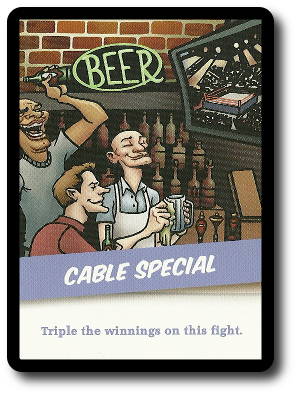
Fifth, if one player wins all 3 bouts at the same location, they earn an additional 3 Million Dollars.
Step 2C: New Locations
When all the bouts at a Location have been completed, it’s time to find a new place to draw crowds and make some money. Any Boxer cards not involved in a Rematch are discarded for the duration of the game. The current Location card is also discarded and a new one is drawn to replace it. If there are any Rematches, they are now placed in the Main Event bout area.
Once the bout is over and new locations revealed, the round continues and returns to step 2A. As more Boxer cards are added, the more bouts will be resolved. After all the players have placed their Boxer card, a new round begins starting with step 1.
Ending the Game
The game ends immediately during step 2C when a new Location card cannot be drawn. Any bouts not yet resolved are cancelled. All players now count their Dollar chips. The player who has made the most money wins the game.
To learn more about Top Promoter, visit the game’s web page.
Final Word
The Child Geeks jumped right into this game with a smile. They liked the game’s theme, although I did have to keep reminding them that they were playing as promoters, not boxers. In response, one Child Geek said, “That’s not true. Every time you roll the dice, you are playing as the boxer.” I stand corrected! The Child Geeks believed they were playing as both the promoter and the boxer, finding both sides of the sport to be interesting and challenging. According to one Child Geek, “I really like how you are playing 2 games. The first is setting up your boxer to win and make a lot of money and the second is the actual boxing match.” But it was not all “fun and games”, so to speak. A number of the Child Geeks grew frustrated with their dice rolls and the high amount of randomness when it came time to box. One Child Geek said, “I guess it’s a lot like real life, but I wish luck didn’t play such a large part in the game.” When all the fights were over, the Child Geeks voted to approve Top Promoter and would happily go another 12 rounds with it any day.

The look on my son’s face when he suddenly “got the game”
The Parent Geeks enjoyed many of the same aspects of the game as the Child Geeks, including the dual roles the players had. According to one Parent Geek, “This is a pretty light game, but I like how you and your opponents build the venue for each location. You need to think before you play your boxer. Play it too soon and you might get poorly matched. Play it too late and you might note have a match at all.” Another Parent Geek said, “The card portion of the game is fun, but I find the dice portion to simply be OK. It’s too random for me and way too dependent on luck.” This was heard again and again, but all the Parent Geeks acknowledged that Top Promoter felt like it was meant to be a light game, so using randomness and luck to replace deep strategical game play and tactics was a good tradeoff. In the end, the Parent Geeks couldn’t find anything wrong with the game, enjoyed themselves when playing it, and liked how easy it was to play with their Child Geeks. They voted to approve Top Promoter as a result.
The Gamer Geeks are not as forgiving or as tolerant as the Child Geeks and the Parent Geeks. According to one Gamer Geek, “This game has promise, but it’s a total luck fest. It doesn’t matter how much energy you put into making a good match if its outcome is determined by a dice roll off.” Another Gamer Geek said, “I like everything about this game except the dice. I wish there was another way – a better way – to determine the winner.” But there were also Gamer Geeks who liked what they saw and how the game was played. According to one of these Gamer Geeks, “It’s not a terribly deep game and it most certainly isn’t the best game I’ve ever played, but I’m having fun. I like how the underdog can win and each boxing match could end with a spectacular KO or result in several rounds of boxing.” Another supportive Gamer Geek said, “The game has an easy system to learn and to use. While I think it removes a lot of what I like about boxing, it does a good job of focusing on the fundamentals.” When it came time to vote, the Gamer Geeks were split. In one corner, wearing the red trunks, were the gaming elitists who believed that Top Promoter was not a game for gamers due to the amount of luck and randomness it had instead of tactics and strategy. In the other corner, wearing the blue trunks, were the gaming elitists who believed that Top Promoter was a light game with light strategy, where dice were used to determine fun and surprising outcomes, resulting in a game that would be good for fillers or just to pass the time.
I rather enjoyed Top Promoters. I found that it had just the right balance of strategic game play and random outcomes. Players can offset the odds of losing by adding more dice to their boxer’s rolls, but there is always a chance that the underdog could win. In some ways, this is very much like the role-playing games I play, where even the smallest of warriors still has a chance to hit the largest of dragons. Not a great chance – slim to none to be honest – but there is a chance. It’s this door of opportunity that makes each boxing match entertaining and fun to play. You simply never know what to expect, but you can go to great lengths to put the odds in your favor.
The only aspect of the game that I wish was included was the ability to bet on other player’s matches. This would keep everyone in the game just a bit more and allow players to grab even more money. We played a bit with betting but were unable to find a balance between speedy game play and meaningful decision making. It remains a topic of interest for those who play the game, but not one that has been fully thought out.
Top Promoters is a fun game. It’s not deep, not terribly difficult, and can feel like a total luck fest at times, but I never felt that it was unbalanced. The smallest of boxers has a chance to take out the biggest of opponents, allowing players to create a David vs. Goliath match or two equally matched boxers can go toe-to-toe. Getting KO’s feels great and playing out a match through several rounds made me giggle when my weak left punch dropped my opponent to the mat after 3 previous rounds of uneventful boxing. Top Promoter entertained and enraged in equal measure. If this sounds like a game you’d like to jump into the ring with, do give Top Promoter a try.
This game was given to Father Geek as a review copy. Father Geek was not paid, bribed, wined, dined, or threatened in vain hopes of influencing this review. Such is the statuesque and legendary integrity of Father Geek.



